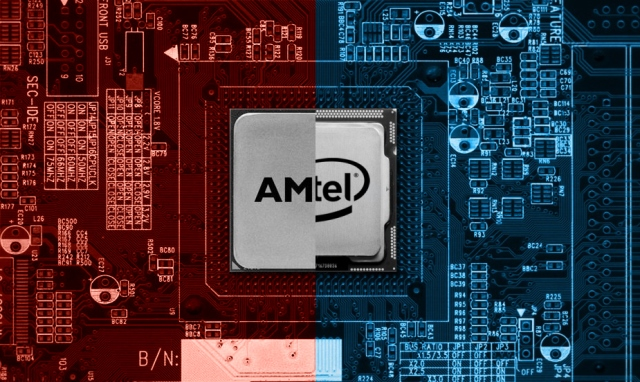Choosing a processor for your computer, two best names dominate the market: Intel and AMD. Both companies have a long history of producing high-performance CPUs, each with its own strengths and unique features. This guide will delve into the details of Intel and AMD processors, comparing their performance, pricing, features, and suitability for various tasks to help you make an informed decision.
Intel vs AMD: Performance
Intel processors typically offer superior single-core performance, making them favored for gaming and single-threaded tasks. AMD processors excel in multi-core performance, providing excellent value for productivity and multi-threaded applications.
Single-Core Performance
Intel processors have traditionally held the edge in single-core performance, thanks to their higher clock speeds and more aggressive turbo boost technologies. This makes Intel CPUs particularly strong in tasks that rely heavily on single-thread performance, such as gaming and certain professional applications.
Multi-Core Performance
AMD has significantly closed the gap with its Ryzen series, especially with the introduction of the Ryzen 9 and Thread Ripper CPUs, which offer a high number of cores and threads. This makes AMD processors highly effective for multi-threaded applications such as video editing, 3D rendering, and complex computational tasks.
Intel vs AMD: Pricing
Intel processors are generally priced higher, reflecting their premium performance and efficiency. AMD Processors offers more cost-effective options, delivering strong multi-core performance and better value for budget-conscious users.
Budget Options
AMD has built a reputation for offering excellent value for money, especially in the mid-range and budget segments. The Ryzen 3 and Ryzen 5 series provide impressive performance at a lower cost compared to their Intel counterparts, making them a popular choice for budget-conscious consumers.
High-End Options
At the high end, Intel’s Core i9 series competes closely with AMD’s Ryzen 9 and Threadripper CPUs. While Intel often charges a premium for its top-tier processors, AMD’s aggressive pricing and competitive performance make it a strong contender in the high-end market as well.
Intel vs AMD: Features
Intel processors often include advanced features like Thunderbolt support and integrated graphics, making them versatile for various applications. AMD processors excel with more cores and threads, providing enhanced performance for multitasking and content creation.
Overclocking
Both Intel and AMD offer processors with unlocked multipliers for overclocking, but AMD generally provides more headroom for enthusiasts. AMD’s Ryzen Master software also simplifies the overclocking process, making it accessible even for less experienced users.
Integrated Graphics
Intel’s CPUs often come with integrated graphics, which can be a significant advantage for users who do not require a dedicated graphics card. AMD’s Ryzen APUs (Accelerated Processing Units) also include integrated graphics, but the performance typically outshines Intel’s offerings in this area.
You May like Also: LCFGamEvent: The Future of Gaming Events Revealed
Intel vs AMD: Compatibility and Upgradability
Intel platforms often require new motherboards for significant upgrades, which can limit upgradability. AMD offers better compatibility and upgradability with their longer-lasting socket support, allowing easier CPU upgrades within the same motherboard generation.
Motherboard Support
Intel and AMD use different sockets and chipsets, which affects motherboard compatibility. AMD’s AM4 socket has been in use for several generations of Ryzen processors, offering better upgradability and future-proofing. Intel, on the other hand, frequently changes its socket designs, which can limit the upgrade paths for older systems.
Memory Support
Both Intel and AMD processors support DDR4 memory, but AMD’s Ryzen series often benefits more from faster RAM due to its Infinity Fabric architecture. This can lead to better overall system performance, especially in memory-intensive applications.
Intel vs AMD: Power Consumption and Heat
Intel CPUs typically offer lower power consumption and run cooler, making them suitable for compact builds and energy-conscious users. AMD CPUs, while powerful, often require more robust cooling solutions due to higher power draw and heat output.
Efficiency
Intel processors tend to have lower thermal design power (TDP) ratings, which can translate to better energy efficiency and lower heat output. This makes Intel CPUs a good choice for compact or low-power builds where heat dissipation is a concern.
Cooling Requirements
AMD’s high-performance CPUs, particularly the Thread Ripper series, can generate more heat and may require more robust cooling solutions. However, AMD’s stock coolers are generally more effective and better designed than Intel’s, providing adequate cooling for most users without the need for aftermarket solutions.
Intel vs AMD: Suitability for Different Tasks
Intel processors excel in single-core tasks like gaming, offering high clock speeds and efficiency. AMD processors are ideal for multi-core tasks such as video editing and 3D rendering, providing superior multi-threaded performance and value.
Gaming
For gaming, Intel’s processors have been the go-to choice due to their superior single-core performance. Games that rely heavily on single-threaded tasks benefit from the higher clock speeds and efficiency of Intel CPUs. However, AMD has made significant strides with its Ryzen 5000 series, which now rivals Intel in gaming performance.
Content Creation
AMD’s multi-core and multi-threaded performance make Ryzen and Thread Ripper CPUs ideal for content creation tasks such as video editing, 3D rendering, and other professional applications. The higher core count and better multi-threaded performance of AMD processors can significantly reduce render times and improve workflow efficiency.
General Use
For general use, both Intel and AMD processors offer excellent performance. Budget-conscious users may lean towards AMD for better value, while those seeking the best out-of-the-box performance without considering overclocking might prefer Intel.
Intel vs AMD: Technological Advancements
Intel continues to innovate with advancements in AI integration and efficiency improvements, while AMD leads in multi-core processing and advanced manufacturing techniques.
Manufacturing Process
AMD has been at the forefront of adopting smaller manufacturing processes, with its latest Ryzen processors built on a 7nm process. This leads to better efficiency and performance. Intel, while traditionally strong in manufacturing, has faced delays in moving to smaller processes but continues to innovate with its upcoming 10nm and 7nm products.
Architectures
AMD’s Zen architecture has been a game-changer, offering significant performance improvements and efficiency over previous generations. Intel’s Alder Lake architecture introduces a hybrid design with both high-performance and high-efficiency cores, promising to revolutionize the CPU landscape.
Intel vs AMD: Market Position and Future Outlook
Intel maintains a strong market position with a focus on high-performance and power-efficient processors, while AMD is gaining ground with competitive multi-core options and aggressive pricing. For a deeper analysis of their market strategies and future prospects.
Intel’s Strategy
Intel has long been the dominant player in the CPU market, focusing on strong single-core performance and integration with other Intel technologies. With the introduction of new architectures and improved manufacturing processes, Intel aims to reclaim its top position in both consumer and professional markets.
AMD’s Rise
AMD’s resurgence with the Ryzen and Thread Ripper series has disrupted the CPU market, challenging Intel’s dominance. AMD’s aggressive pricing, innovative technology, and consistent performance improvements have earned it a significant market share. Looking forward, AMD’s continued focus on multi-core performance and efficiency will likely drive further advancements and competition.
Intel vs AMD: Consumer Decision-Making
Choosing between Intel and AMD often depends on the specific needs of the consumer. Intel generally offers better single-core performance and efficiency, making it ideal for tasks like gaming. For more detailed insights into how Intel and AMD compare across various use cases, read below.
Personal Needs
Ultimately, the choice between Intel and AMD comes down to personal needs and budget. Gamers who prioritize single-core performance might prefer Intel, while content creators and professionals who benefit from multi-core performance might opt for AMD.
Brand Loyalty
Brand loyalty can also influence decision-making. Long-time users of either Intel or AMD may stick with what they know and trust. However, given the competitive landscape, it’s worth considering both options and choosing the one that best fits your specific requirements.
Where to Buy Intel and AMD Processors?
When deciding between Intel and AMD processors, it’s essential to purchase from Computing Worlds to ensure you get a genuine product with a valid warranty. Look for authorized dealers and online platforms with good reviews and customer service.
Choosing between Intel and AMD CPUs involves weighing performance, pricing, features, and your specific needs. Intel excels in single-core performance, making it ideal for gaming, while AMD’s multi-core prowess is perfect for content creation and multi-threaded tasks. Both brands offer excellent options across various price ranges, ensuring there’s a suitable processor for every user. Ultimately, the best choice depends on your personal requirements and budget, making it essential to research and compare the latest offerings from both Intel and AMD.




